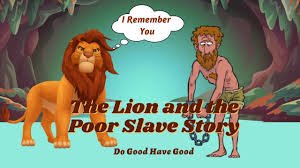The ancient fable of The Lion and the Poor Slave, often overshadowed by more popular Aesop’s tales, carries a timeless message about mercy, reciprocity, and the unexpected bonds that can form between the most unlikely of companions. While many assume this story originated with Aesop in the 6th century BCE, historians trace its earliest versions to Indian and Middle Eastern folklore, where it appeared in various forms before being adopted into Greek tradition. The most famous iteration comes from the Roman-era Aesopica, where it was recorded as Androcles and the Lion, though its core themes remain consistent across cultures: an act of compassion, no matter how small, can alter the course of fate. The story’s endurance over millennia speaks to its universal resonance—whether told as a moral lesson in ancient Athens or adapted into Christian parables about redemption, it continues to captivate audiences with its blend of danger, tenderness, and poetic justice.
At the heart of the tale is the slave, often named Androcles in later versions, who flees his cruel master and seeks refuge in the wilderness. Unlike the sanitized retellings popular today, early versions emphasize the slave’s desperation—his tattered clothing, hunger, and the ever-present threat of capture and execution under Roman law. This context is crucial, as it transforms his encounter with the lion from mere chance into a moment of mutual vulnerability. When he discovers the beast in agony from a thorn embedded in its paw, his decision to help is not just brave but radically empathetic. The original texts describe how the slave, despite his fear, recognizes the lion’s suffering as akin to his own, a subtle nod to the Stoic philosophy of universal kinship that influenced Aesop’s era. The lion’s subsequent gratitude—sparing the slave and later refusing to attack him when they meet again in the arena—becomes a metaphor for the idea that even the fiercest forces of nature (or society) can be swayed by kindness.
The lion itself is a figure of profound symbolism. In ancient cultures, lions represented both untamed danger and royal authority, making its submission to the slave a subversive act. Some scholars argue this dynamic critiques the social hierarchies of the ancient world, suggesting that true nobility lies in moral action rather than birthright. The arena scene, where the lion recognizes the slave before a stunned audience, appears in Roman accounts as early as the 1st century CE, often with added details—the crowd’s gasps, the emperor’s pardon, and the pair’s eventual freedom. These elements, while likely embellished over time, reinforce the story’s central paradox: that the “lowliest” (a slave) and the “wildest” (a lion) could teach civilized society about justice.
Modern psychology offers an intriguing lens on the tale. The lion’s memory of the slave’s kindness mirrors studies on animal reciprocity, particularly in apex predators. Meanwhile, the slave’s ability to see past his fear aligns with research on empathy as a survival mechanism. Less discussed is the story’s theological influence—early Christian writers adapted it to illustrate divine mercy, while Buddhist jataka tales framed it as a lesson in karmic retribution. Even the slave’s name, Androcles (meaning “man of glory” in Greek), hints at the story’s deeper layers: true glory comes not from power but from compassion.
Today, the fable’s legacy endures in unexpected ways. It inspired George Bernard Shaw’s 1912 play Androcles and the Lion, which added satire and socialist themes, while neuroscientists cite it when discussing cross-species empathy. Its core message—that no act of goodness is ever wasted—resonates in an age of social divisions, reminding us that even in the harshest circumstances, humanity (and animal kindness) can prevail.
Go to main page


